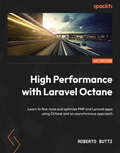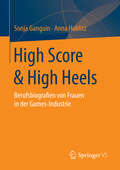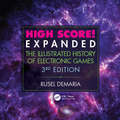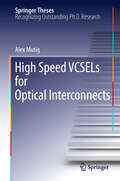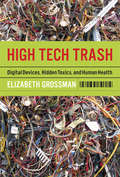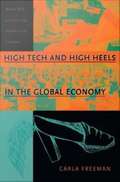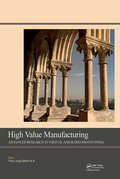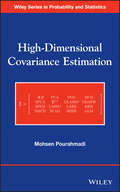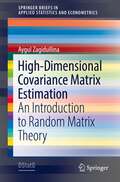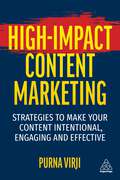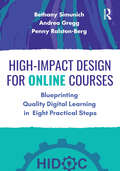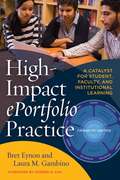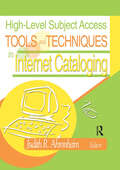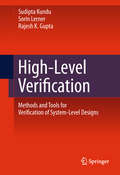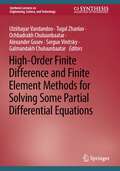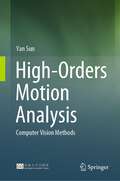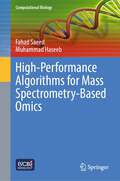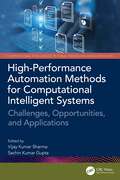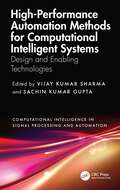- Table View
- List View
High Performance with Laravel Octane: Learn to fine-tune and optimize PHP and Laravel apps using Octane and an asynchronous approach
by Roberto ButtiExplore tools, techniques, and practices to remove performance bottlenecks and enhance the stability of your Laravel and PHP web applicationsKey FeaturesGet a complete view of what it takes to design and build a high-performing application with OctaneReuse objects across requests and execute application logic asynchronouslyLearn key elements to design and build a performance-optimized and production-ready applicationBook DescriptionLaravel Octane is a very powerful component in the Laravel ecosystem that can help you achieve remarkable app performance. With Laravel Octane, you will find tools (queues, cache, and tables) that facilitate a new asynchronous approach for improving application performance. This book highlights how Laravel Octane works, what steps to take in designing an application from the start, what tools you have at your disposal, and how to set up production environments. It provides complete coverage of the strategies, tools, and best practices to make your apps scalable and performant. This is especially important as optimization is usually the overlooked part in the application development lifecycle. You will explore the asynchronous approach in Laravel and be able to release high-performing applications that have a positive impact on the end-user experience. By the end of this book, you will find yourself designing, developing, and releasing high-performance applications.What you will learnUnderstand the dynamics of the request life cycle in a classic Laravel applicationExplore possibilities with OpenSwoole and Roadrunner and choose the best solution for your applicationAnalyze the potential bottlenecks of a classic web applicationConfigure Laravel Octane with Roadrunner and OpenSwooleImplement functionality using asynchronous mechanisms and run tasks in parallel in the Laravel appPrepare the production environment to host Laravel Octane and its dependenciesUnderstand the pros and cons of applying potential enhancements to your Laravel appWho this book is forThe book is for existing Laravel developers who want to improve their software architecture, from a basic or standard architecture to a more scalable and performant one. Basic knowledge of Laravel fundamentals is required.
High Performance with MongoDB: Best practices for performance tuning, scaling, and architecture
by Alex Bevilacqua Asya Kamsky Ger HartnettPractical strategies to help you design, optimize, and operate MongoDB deployments for performance, resilience, and growthKey FeaturesIdentify and fix performance bottlenecks with practical diagnostic and optimization strategiesOptimize schema design, indexing, storage, and system resources for real-world workloadsScale confidently with in-depth coverage of replication, sharding, and cluster management techniquesPurchase of the print or Kindle book includes a free PDF eBookBook DescriptionWith data as the new competitive edge, performance has become the need of the hour. As applications handle exponentially growing data and user demand for speed and reliability rises, three industry experts distill their decades of experience to offer you guidance on designing, building, and operating databases that deliver fast, scalable, and resilient experiences. MongoDB’s document model and distributed architecture provide powerful tools for modern applications, but unlocking their full potential requires a deep understanding of architecture, operational patterns, and tuning best practices. This MongoDB book takes a hands-on approach to diagnosing common performance issues and applying proven optimization strategies from schema design and indexing to storage engine tuning and resource management. Whether you’re optimizing a single replica set or scaling a sharded cluster, this book provides the tools to maximize deployment performance. Its modular chapters let you explore query optimization, connection management, and monitoring or follow a complete learning path to build a rock-solid performance foundation. With real-world case studies, code examples, and proven best practices, you’ll be ready to troubleshoot bottlenecks, scale efficiently, and keep MongoDB running at peak performance in even the most demanding production environments.What you will learnDiagnose and resolve common performance bottlenecks in deploymentsDesign schemas and indexes that maximize throughput and efficiencyTune the WiredTiger storage engine and manage system resources for peak performanceLeverage sharding and replication to scale and ensure uptimeMonitor, debug, and maintain deployments proactively to prevent issuesImprove application responsiveness through client driver configurationWho this book is forThis book is for developers, database administrators, system architects, and DevOps engineers focused on performance optimization of MongoDB. Whether you’re building high-throughput applications, managing deployments in production, or scaling distributed systems, you’ll gain actionable insights. Basic knowledge of MongoDB is assumed, with chapters designed progressively to support learners at all levels.
High Score & High Heels
by Sonja Ganguin Anna HoblitzDer Games-Markt in Deutschland zählt ca. 26 Millionen Spielerinnen und Spieler. Obwohl in Deutschland somit fast jede dritte Person spielt und mittlerweile fast die Hälfte der Spieler weiblich ist, ist die Games-Industrie stark männerdominiert. Wie jedoch würden Frauen, die in der Computerspiel-Industrie Karriere machen oder gemacht haben, selbst ihren Beruf beschreiben? Bisher ist wenig über ihre Biografien, Karrieren, Einstellungen und Ansichten zur Branche bekannt. Um Antworten auf diese Fragen zu finden, wurden Experteninterviews mit Frauen geführt, die in der Games-Industrie arbeiten. Ziel der Experteninterviews war es, Entwicklungspfade sowie Chancen und Herausforderungen für Frauen in der Games-Branche aus verschiedenen Perspektiven zu beleuchten, um ein umfassendes Verständnis für die einzelnen Facetten zu erlangen.
High Score! Expanded: The Illustrated History of Electronic Games 3rd Edition
by Rusel DeMariaIn this lavishly illustrated full-color retrospective, discover never-before-seen photos that bring to life the people and stories behind the most popular games of all time, including Space Invaders, Pac-Man, Centipede, Donkey Kong, Asteroids, SimCity, Quake, Myst, Tomb Raider, and more. This is the inside scoop on the history, successes, tricks, and even failures of the entire electronic games industry.
High Speed VCSELs for Optical Interconnects
by Alex MutigThe transmission speed of data communication systems is forecast to increase exponentially over the next decade. Development of both Si-based high-speed drivers as well as III-V-semiconductor-based high-speed vertical cavity surface emitting lasers (VCSELs) are prerequisites for future ultrahigh data-rate systems. This thesis presents: - a survey of the present state of the art of VCSELs - a systematic investigation of the various effects limiting present VCSELs - a catalogue of solutions to overcome present limits - detailed progress in modelling, fabricating and testing the currently most advanced VCSELs at the two commercially most important wavelengths.
High Tech Heretic: Why Computers Don't Belong in the Classroom and Other Reflections by a Computer Contrarian
by Clifford StollInteresting analysis of the use and misuse of technology in education.
High Tech Trash: Digital Devices, Hidden Toxics, and Human Health
by Elizabeth GrossmanThe Digital Age was expected to usher in an era of clean production, an alternative to smokestack industries and their pollutants. But as environmental journalist Elizabeth Grossman reveals in this penetrating analysis of high tech manufacture and disposal, digital may be sleek, but it's anything but clean. Deep within every electronic device lie toxic materials that make up the bits and bytes, a complex thicket of lead, mercury, cadmium, plastics, and a host of other often harmful ingredients.High Tech Trash is a wake-up call to the importance of the e-waste issue and the health hazards involved. Americans alone own more than two billion pieces of high tech electronics and discard five to seven million tons each year. As a result, electronic waste already makes up more than two-thirds of the heavy metals and 40 percent of the lead found in our landfills. But the problem goes far beyond American shores, most tragically to the cities in China and India where shiploads of discarded electronics arrive daily. There, they are "recycled"-picked apart by hand, exposing thousands of workers and community residents to toxics.As Grossman notes, "This is a story in which we all play a part, whether we know it or not. If you sit at a desk in an office, talk to friends on your cell phone, watch television, listen to music on headphones, are a child in Guangdong, or a native of the Arctic, you are part of this story."The answers lie in changing how we design, manufacture, and dispose of high tech electronics. Europe has led the way in regulating materials used in electronic devices and in e-waste recycling. But in the United States many have yet to recognize the persistent human health and environmental effects of the toxics in high tech devices. If Silent Spring brought national attention to the dangers of DDT and other pesticides, High Tech Trash could do the same for a new generation of technology's products.
High Tech and High Heels in the Global Economy: Women, Work, and Pink-Collar Identities in the Caribbean
by Carla FreemanHigh Tech and High Heels in the Global Economy is an ethnography of globalization positioned at the intersection between political economy and cultural studies. Carla Freeman's fieldwork in Barbados grounds the processes of transnational capitalism--production, consumption, and the crafting of modern identities--in the lives of Afro-Caribbean women working in a new high-tech industry called "informatics. " It places gender at the center of transnational analysis, and local Caribbean culture and history at the center of global studies. Freeman examines the expansion of the global assembly line into the realm of computer-based work, and focuses specifically on the incorporation of young Barbadian women into these high-tech informatics jobs. As such, Caribbean women are seen as integral not simply to the workings of globalization but as helping to shape its very form. Through the enactment of "professionalism" in both appearances and labor practices, and by insisting that motherhood and work go hand in hand, they re-define the companies' profile of "ideal" workers and create their own "pink-collar" identities. Through new modes of dress and imagemaking, the informatics workers seek to distinguish themselves from factory workers, and to achieve these new modes of consumption, they engage in a wide array of extra income earning activities. Freeman argues that for the new Barbadian pink-collar workers, the globalization of production cannot be viewed apart from the globalization of consumption. In doing so, she shows the connections between formal and informal economies, and challenges long-standing oppositions between first world consumers and third world producers, as well as white-collar and blue-collar labor. Written in a style that allows the voices of the pink-collar workers to demonstrate the simultaneous burdens and pleasures of their work, High Tech and High Heels in the Global Economy will appeal to scholars and students in a wide range of disciplines, including anthropology, cultural studies, sociology, women's studies, political economy, and Caribbean studies, as well as labor and postcolonial studies.
High Throughput Imaging Technology (Advances in Optics and Optoelectronics)
by Yutong Li Zhengjun LiuThis book highlights a comprehensive introduction to high-throughput imaging, with the focus on the principles and methods. High-throughput imaging has become a research trend in the field of optics. It combines fast imaging, super-resolution imaging and large field of view imaging, improving the performance of the imaging system in many aspects. The development of a fast and high-throughput imaging system requires integration of optics, mathematics, programming, and other related science and technology. They bridge the theory and the system and realize the software-hardware integration, finally achieving high-performance imaging. An effective evaluation criterion of high-throughput imaging is the spatio-temporal bandwidth product, which provides guidance for research. The imaging technology with better comprehensive performance is the key target of research. Nowadays, new super-resolution imaging technologies and high-throughput imaging technologies have been emerging one after another, together with a number of new technical indicators. However, the integration and cascade of various technologies is still a very difficult challenge, and different technologies are difficult to be used in combination because of differences in physical space and technical means. Creating an imaging system with fast and high-throughput imaging capability is an urgent research task, which has important economic and social benefits for practical applications such as observing the dynamic (transient) process of large-size targets and on-line detection. High-throughput imaging is one of the major research goals of global research teams in optical imaging. This book summarizes latest research advances and introduces a variety of imaging methods targeting key problems, bringing together new theories and technologies in the aspects of high resolution, large field of view and fast imaging. The book provides a handy reference and systematic handbook for graduate students, researchers, and technicians engaged in the study, research and work in optical imaging.
High Value Manufacturing: Proceedings of the 6th International Conference on Advanced Research in Virtual and Rapid Prototyping, Leiria, Portugal, 1-5 October, 2013
by Miguel Gaspar Flávio Craveiro Helena Maria Coelho da Rocha Terreiro Galha Bártolo Paulo Jorge da Silva Bártolo Nuno Manuel Fernandes Alves Carina Ramos Lina Durão Telma Ferreira Ana Cristina Soares de Lemos António Mário Henriques Pereira Cyril Dos Santos Artur Jorge dos Santos Mateus David Oliveira Elodie Pinto Henrique de Amorim Almeia Inês Sousa João Manuel Matias Pedro Carreira Tiago MarquesHigh Value Manufacturing is the result of the 6th International Conference on Advanced Research in Virtual and Rapid Prototyping, held in Leiria, Portugal, October 2013. It contains current contributions to the field of virtual and rapid prototyping (V&RP) and is also focused on promoting better links between industry and academia. This book contains current contributions to the field of virtual and rapid prototyping (V&RP) and is also focused on promoting better links between industry and academia. It covers a wide range of topics, such as additive and nano manufacturing technologies, biomanufacturing, materials, rapid tooling and manufacturing, CAD and 3D data acquisition technologies, simulation and virtual environments, and novel applications. The book is intended for engineers, designers and manufacturers who are active in the fields of mechanical, industrial and biomedical engineering.
High-Bandwidth Memory Interface
by Chulwoo Kim Junyoung Song Hyun-Woo LeeThis book provides an overview of recent advances in memory interface design at both the architecture and circuit levels. Coverage includes signal integrity and testing, TSV interface, high-speed serial interface including equalization, ODT, pre-emphasis, wide I/O interface including crosstalk, skew cancellation, and clock generation and distribution. Trends for further bandwidth enhancement are also covered.
High-Dimensional Covariance Estimation
by Mohsen PourahmadiMethods for estimating sparse and large covariance matricesCovariance and correlation matrices play fundamental roles in every aspect of the analysis of multivariate data collected from a variety of fields including business and economics, health care, engineering, and environmental and physical sciences. High-Dimensional Covariance Estimation provides accessible and comprehensive coverage of the classical and modern approaches for estimating covariance matrices as well as their applications to the rapidly developing areas lying at the intersection of statistics and machine learning.Recently, the classical sample covariance methodologies have been modified and improved upon to meet the needs of statisticians and researchers dealing with large correlated datasets. High-Dimensional Covariance Estimation focuses on the methodologies based on shrinkage, thresholding, and penalized likelihood with applications to Gaussian graphical models, prediction, and mean-variance portfolio management. The book relies heavily on regression-based ideas and interpretations to connect and unify many existing methods and algorithms for the task.High-Dimensional Covariance Estimation features chapters on:Data, Sparsity, and RegularizationRegularizing the EigenstructureBanding, Tapering, and ThresholdingCovariance MatricesSparse Gaussian Graphical ModelsMultivariate RegressionThe book is an ideal resource for researchers in statistics, mathematics, business and economics, computer sciences, and engineering, as well as a useful text or supplement for graduate-level courses in multivariate analysis, covariance estimation, statistical learning, and high-dimensional data analysis.
High-Dimensional Covariance Matrix Estimation: An Introduction to Random Matrix Theory (SpringerBriefs in Applied Statistics and Econometrics)
by Aygul ZagidullinaThis book presents covariance matrix estimation and related aspects of random matrix theory. It focuses on the sample covariance matrix estimator and provides a holistic description of its properties under two asymptotic regimes: the traditional one, and the high-dimensional regime that better fits the big data context. It draws attention to the deficiencies of standard statistical tools when used in the high-dimensional setting, and introduces the basic concepts and major results related to spectral statistics and random matrix theory under high-dimensional asymptotics in an understandable and reader-friendly way. The aim of this book is to inspire applied statisticians, econometricians, and machine learning practitioners who analyze high-dimensional data to apply the recent developments in their work.
High-Dimensional and Low-Quality Visual Information Processing
by Yue DengThis thesis primarily focuses on how to carry out intelligent sensing and understand the high-dimensional and low-quality visual information. After exploring the inherent structures of the visual data, it proposes a number of computational models covering an extensive range of mathematical topics, including compressive sensing, graph theory, probabilistic learning and information theory. These computational models are also applied to address a number of real-world problems including biometric recognition, stereo signal reconstruction, natural scene parsing, and SAR image processing.
High-Impact Content Marketing: Strategies to Make Your Content Intentional, Engaging and Effective
by Purna VirjiCreate meaningful engagement, drive conversion rates and boost customer retention with this crucial resource to unlocking the true potential of your content marketing strategy.In an era of user-generated, human-generated and machine-generated content, mistakes are increasingly costlier to make. And more difficult to recover from. To succeed in the highly competitive creator economy of today and the future, content marketers need to rethink their approach or go the way of the dinosaurs.High-Impact Content Marketing shows how to succeed by taking a simplified yet strategic approach to standing out and driving revenue impact. It covers time-proven strategies to create video, audio, social media and longer-form content that audiences will actually want to consume and how to do so in a genuinely inclusive way. It also shows how to master content distribution across channels such as websites, blogs, email and social media networks to maximize reach, engagement and impact. What makes High-Impact Content Marketing unique is how it weaves in behavioral science and adult learning principles to maximize and measure impact. It features easy-to-implement frameworks and actionable guides throughout as well as examples of best-in-class content marketing from the likes of Patagonia, Microsoft, Spotify and Google plus interviews with top industry experts from across the globe. Guidance is also included on how to align content with various stages of the customer journey. This is an essential blueprint for ensuring the long-term success of your content marketing strategy to increase brand awareness, build relationships and boost conversions.
High-Impact Design for Online Courses: Blueprinting Quality Digital Learning in Eight Practical Steps
by Andrea Gregg Bethany Simunich Penny Ralston-BergHigh-Impact Design for Online Courses introduces higher education professionals to an eight-step course design model that leverages the unique considerations of online and hybrid modalities at each stage in the process. Though relevant to and informed by instructional designers and educational technologists, this book is specifically geared toward faculty who lack the administrative and technical supports they need to thrive in the new normal. Each chapter includes step-by-step guidance on learner analysis, course structure, appropriate activities and assessments, continuous improvement, and other key elements of a successful digital course. Teachers across disciplines and levels of experience will come away newly inspired and motivated with fresh insights into planning and drafting, practical tips for pedagogy and design, opportunities for self-reflection and course revision, and implications for learner-centered delivery.
High-Impact eportfolio Practice: A Catalyst for Student, Faculty and Institutional Learning
by Bret Eynon Laura M. GambinoAt a moment when over half of US colleges are employing ePortfolios, the time is ripe to develop their full potential to advance integrative learning and broad institutional change. The authors outline how to deploy the ePortfolio as a high-impact practice and describe widely-applicable models of effective ePortfolio pedagogy and implementation that demonstrably improve student learning across multiple settings. Drawing on the campus ePortfolio projects developed by a constellation of institutions that participated in the Connect to Learning network, Eynon and Gambino present a wealth of data and revealing case studies. Their broad-based evidence demonstrates that, implemented with a purposeful framework, ePortfolios correlate strongly with increased retention and graduation rates, broadened student engagement in deep learning processes, and advanced faculty and institutional learning. The core of the book presents a comprehensive research-based framework, along with practical examples and strategies for implementation, and identifies the key considerations that need to be addressed in the areas of Pedagogy, Professional Development, Outcomes Assessment, Technology and Scaling Up. The authors identify how the ePortfolio experience enhances other high-impact practices (HIPs) by creating unique opportunities for connection and synthesis across courses, semesters and co-curricular experiences. Using ePortfolio to integrate learning across multiple HIPs enables students reflect and construct a cohesive signature learning experience. This is an invaluable resource for classroom faculty and educational leaders interested in transformative education for 21st century learners.
High-Level Models of Unconventional Computations: A Case Of Plasmodium (Studies in Systems, Decision and Control #159)
by Krzysztof Pancerz Andrew SchumannThis book shows that the plasmodium of Physarum polycephalum can be considered a natural labelled transition system, and based on this, it proposes high-level programming models for controlling the plasmodium behaviour. The presented programming is a form of pure behaviourism: the authors consider the possibility of simulating all basic stimulus–reaction relations. As plasmodium is a good experimental medium for behaviouristic models, the book applies the programming tools for modelling plasmodia as unconventional computers in different behavioural sciences based on studying the stimulus–reaction relations. The authors examine these relations within the framework of a bio-inspired game theory on plasmodia they have developed i.e. within an experimental game theory, where, on the one hand, all basic definitions are verified in experiments with Physarum polycephalum and Badhamia utricularis and, on the other hand, all basic algorithms are implemented in the object-oriented language for simulations of plasmodia. The results allow the authors to propose that the plasmodium can be a model for concurrent games and context-based games.
High-Level Subject Access Tools and Techniques in Internet Cataloging
by Judith AhronheimIs your library's portal as efficient as it could be? High-Level Subject Access Tools and Techniques explores the potential and early development of high-level subject access. It examines Web tools and traditionally maintained library structures that facilitate the automated relation of resources to high-level subject categories based on the descriptive metadata that already exists in traditional library records. It includes a research study of high-level subject browse structures, as well as hands-on reports of actual projects and development activities and an examination of the environment in which demand for high-level subject access arises. From the editor: As the World Wide Web and graphic user interfaces developed in the 90s, libraries began to build gateways for their online resources. These gateways allowed library users to employ the browse, point, and click approach to resource discovery that they had come to expect from online tools. Most of these interfaces amounted to little more than hand-constructed lists of links. Today, many libraries offer access to users through a set list of broad topics, sometimes called a high-level browse display. Methods for populating these subject categories remain crude and their maintenance requires considerable resources. As a result, libraries have begun to look at ways of applying traditional techniques associated with cataloging to these new interfaces. Several goals are involved in these developments. Many hope to reuse data from library catalogs and thus limit maintenance burdens. Others seek to apply a more standard set of tools and principles to the construction of portals to allow greater cooperation among institutions that want to interoperate with each other. This pathbreaking book examines vital issues in high-level subject access, including: subject trees and their relationship to the structure inherent in Dewey Classification emerging patterns in the development of browsing services, including a hierarchy of subjects that is not based in classification, a map that relates data from catalog records to the subject hierarchy, and tools for extracting data from a catalog and storing it in a separate database to produce a more flexible display task-based (as opposed to materials-based) subject lists the social issues that are associated with choosing categoriesbased on the nature and activity of an institution's library users the political issues involved in selecting disciplines or topics for a browsing service And presents fascinating case studies of: Columbia University's efforts to build an automatically generated browsable display based on Library of Congress Classification as it occurs in catalog records the High-Level Thesaurus Project (HILT), in which a group of libraries, archives, and museums attempted to find a common method for high-level subject access via portal
High-Level Verification
by Sorin Lerner Sudipta Kundu Rajesh K. GuptaGiven the growing size and heterogeneity of Systems on Chip (SOC), the design process from initial specification to chip fabrication has become increasingly complex. This growing complexity provides incentive for designers to use high-level languages such as C, SystemC, and SystemVerilog for system-level design. While a major goal of these high-level languages is to enable verification at a higher level of abstraction, allowing early exploration of system-level designs, the focus so far for validation purposes has been on traditional testing techniques such as random testing and scenario-based testing. This book focuses on high-level verification, presenting a design methodology that relies upon advances in synthesis techniques as well as on incremental refinement of the design process. These refinements can be done manually or through elaboration tools. This book discusses verification of specific properties in designs written using high-level languages, as well as checking that the refined implementations are equivalent to their high-level specifications. The novelty of each of these techniques is that they use a combination of formal techniques to do scalable verification of system designs completely automatically. The verification techniques presented in this book include methods for verifying properties of high-level designs and methods for verifying that the translation from high-level design to a low-level Register Transfer Language (RTL) design preserves semantics. Used together, these techniques guarantee that properties verified in the high-level design are preserved through the translation to low-level RTL.
High-Order Finite Difference and Finite Element Methods for Solving Some Partial Differential Equations (Synthesis Lectures on Engineering, Science, and Technology)
by Ulziibayar Vandandoo Tugal Zhanlav Ochbadrakh Chuluunbaatar Alexander Gusev Sergue Vinitsky Galmandakh ChuluunbaatarThe monograph is devoted to the construction of the high-order finite difference and finite element methods for numerical solving multidimensional boundary-value problems (BVPs) for different partial differential equations, in particular, linear Helmholtz and wave equations, nonlinear Burgers’ equations, and elliptic (Schrödinger) equation. Despite of a long history especially in development of the theoretical background of these methods there are open questions in their constructive implementation in numerical solving the multidimensional BVPs having additional requirement on physical parameters or desirable properties of its approximate solutions. Over the last two decades many papers on this topics have been published, in which new constructive approaches to numerically solving the multidimensional BVPs were proposed, and its highly desirable to systematically collect these results. This motivate us to write thus monograph based on our research results obtained in collaboration with the co-authors. Since the topic is importance we believe that this book will be useful to readers, graduate students and researchers interested in the field of computational physics, applied mathematics, numerical analysis and applied sciences
High-Orders Motion Analysis: Computer Vision Methods
by Yan SunThis book shows how different types of motion can be disambiguated into their components in a richer way than that currently possible in computer vision. Previous research of motion analysis has generally not yet considered the basic nature of higher orders of motion such as acceleration. Hence, this book introduces an approximation of the acceleration field using established optical flow techniques. Further, acceleration is decomposed into radial and tangential based on geometry and propagated as a general motion descriptor; this book shows the capability for differentiating different types of motion both on synthesized data and real image sequences. Beyond acceleration, the higher orders of motion flow and their continuant parts are investigated for further revealing the chaotic motion fields. Naturally, it is possible to extend this notion further: to detect higher orders of image motion. In this respect, this book shows how jerk and snap can be obtained from image sequences. The derived results on test images and heel strike detection in gait analysis illustrate the ability of higher-order motion, which provide the basis for the following research and applications in the future. We hope that the publication of this book will bring a new perspective to researchers and graduate students in the field of video analysis in computer vision.
High-Performance Algorithms for Mass Spectrometry-Based Omics (Computational Biology)
by Fahad Saeed Muhammad HaseebTo date, processing of high-throughput Mass Spectrometry (MS) data is accomplished using serial algorithms. Developing new methods to process MS data is an active area of research but there is no single strategy that focuses on scalability of MS based methods. Mass spectrometry is a diverse and versatile technology for high-throughput functional characterization of proteins, small molecules and metabolites in complex biological mixtures. In the recent years the technology has rapidly evolved and is now capable of generating increasingly large (multiple tera-bytes per experiment) and complex (multiple species/microbiome/high-dimensional) data sets. This rapid advance in MS instrumentation must be matched by equally fast and rapid evolution of scalable methods developed for analysis of these complex data sets. Ideally, the new methods should leverage the rich heterogeneous computational resources available in a ubiquitous fashion in the form of multicore, manycore, CPU-GPU, CPU-FPGA, and IntelPhi architectures. The absence of these high-performance computing algorithms now hinders scientific advancements for mass spectrometry research. In this book we illustrate the need for high-performance computing algorithms for MS based proteomics, and proteogenomics and showcase our progress in developing these high-performance algorithms.
High-Performance Automation Methods for Computational Intelligent Systems: Challenges, Opportunities, and Applications (Computational Intelligence in Signal Processing and Automation)
by Vijay Kumar Sharma Sachin Kumar GuptaIntelligent computation is the need of the current society. This field attracts significant attention due to its application‑oriented systems. It is essential for implementing various society‑related solutions. Automation methods help improve the quality of life and support the development of efficient systems. The available theories and concepts are implemented for the benefit of society, drastically changing the world. The advancement of the existing ideas is simulated in the scenario of future intelligent automation systems. The complicated problems can be easily solved using the mentioned approaches. The decisive nature of the algorithms builds the system more intelligent. This book targets current trends in the relevant field and outlines a path for the development of future automated systems. The intelligence behaviour of the systems is the prime requirement for the age development. The gaps in the current development scenarios need to be identified and bridged by incorporating highly efficient algorithms, ideas, and working prototypes.This book:• Presents a comprehensive survey, performance analysis, and time complexity comparison of machine learning techniques in network security.• Discusses energy‑efficient hybrid algorithms for reconfiguration in radial distribution systems.• Covers a detailed examination of automation approaches for the study and detection of disparate leaf diseases using computational intelligent systems.• Illustrates applications of quantum cellular energy‑efficient computing methods for automation.• Explain cybersecurity strategies for advanced computational intelligence and customer segmentation through machine learning techniques.The book is primarily written for senior undergraduates, graduate students, and academic researchers in the fields of electrical engineering, electronics and communications engineering, computer science and engineering, and information technology.
High-Performance Automation Methods for Computational Intelligent Systems: Design and Enabling Technologies (Computational Intelligence in Signal Processing and Automation)
by Vijay Kumar Sharma Sachin Kumar GuptaComputational methods are necessary for the proper execution of the applications for the benefit of society and technological development. Technological development makes life easier by constructing powerful systems with the help of computational methods. The nature of computational methods changes from time to time and retains only efficient applicable theories. Researchers take the idea of existing computational systems and advance them as per possible future needs. Efficient computational methods solve complex problems and also help to make the system more intelligent. Automation process requires decision-making computational systems. A more intelligent system contains an efficient computational method, which is described by powerful algorithm development. The aim of this book is to identify the technological development for future computational systems, which ultimately reflects the more intelligent system. Automation has become the need of the hour in today’s world, and hence, the computational systems need to be upgraded to that level to perform the required tasks. The most efficient computational algorithm acts like a human being and offers a full sense of intelligent automation.This book: Presents the latest research trends for the upcoming computational intelligent systems in a comprehensive manner Focuses on the integration of multi-purpose and multi-dimension natural language into intelligent systems Elaborates on nature-inspired and intelligent behaviour-based computational methods to deal with the observation of nature Illustrates applications of quantum cellular energy-efficient computing methods for automation and applications of genetic algorithms in multidisciplinary fields Discusses aspects of intelligent automation like technology-based, architecture-based, logic implementation-based, and the different algorithms-based concepts It is primarily written for senior undergraduates, graduate students, and academic researchers in the fields of electrical engineering, electronics and communications engineering, computer science and engineering, and information technology.
